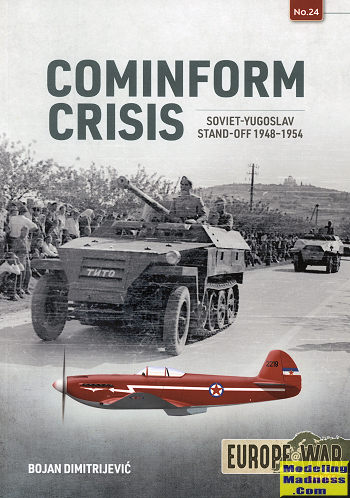 After WW2, the
Soviet Union sought to basically put all of eastern Europe under its control.
While this worked in much of the area, in Yugoslavia, things did not go as
Stalin had planned. Yugoslavia had a very strong dictator in the form of Tito,
who had lead a large Yugoslav partisan army in their defeat of the Germans.
After WW2, the
Soviet Union sought to basically put all of eastern Europe under its control.
While this worked in much of the area, in Yugoslavia, things did not go as
Stalin had planned. Yugoslavia had a very strong dictator in the form of Tito,
who had lead a large Yugoslav partisan army in their defeat of the Germans.
Initially, like the other Soviet-dominated states, Tito
needed Soviet support in rebuilding his military forces. While Stalin did
initially provide replacement tanks, other vehicles, guns, and ammunition, it
came with a price. That price was Soviet 'advisors' in fairly high military
positions. This was initially tolerated as Yugoslavs were sent abroad to various
Soviet military schools as well as being educated in other Soviet bloc nations.
Basically it was supposed to be one big happy communist family. Indeed,
Yugoslavia also hosted military students from other nations such as nearby
Albania, Bulgaria and Hungary.
However, Tito and his generals grated at what they saw
as a haughty take-over of their military by the Soviet Union. This caused a
rift, which, by 1948, resulted in the expulsion of Yugoslavia from the Cominform
or the communist brotherhood of nations. With this expulsion, all Soviet
advisors left. It also resulted in the cessation of deliveries of equipment and
spare parts. Fortunately, Tito was quickly rebuilding Yugoslavia's military
manufacturing capabilities.
Thus began seven years of hostilities, between
Yugoslavia and those nations that bordered the country. Border incursions became
more and more frequent with firing into the nation occasionally killing border
guards. Naturally, this was not a good thing and there were retaliatory raids
made.
One of the benefits of this whole situation is that
Yugoslavia became more and more open to the west. The US and NATO saw this as an
opportunity and started supplying equipment under the Mutual Defense Assistance
Program (MDAP). It is how Yugoslavia got jet fighters and more modern western
equipment, mostly from the US. Eventually the crisis started to wind down after
the death of Stalin in 1953 and by 1955 Khrushchev visited Yugoslavia and
offered an apology for their treatment of the country.
So what we have here is another fascinating look at an
early Cold War crisis about which many westerners know little or nothing. The
author has certainly done his research on this one and provides us a level of
detail that makes for a great read. It is a book that is very much worth picking
up and reading.
April 2023
Copyright ModelingMadness.com. All rights reserved. No
reproduction without express permission.
Review book courtesy of
Casemate Publishing, where you can order your copy
at this
link.
If you would like your product reviewed fairly and quickly, please
contact
me or see other details in the
Note to
Contributors.
 After WW2, the
Soviet Union sought to basically put all of eastern Europe under its control.
While this worked in much of the area, in Yugoslavia, things did not go as
Stalin had planned. Yugoslavia had a very strong dictator in the form of Tito,
who had lead a large Yugoslav partisan army in their defeat of the Germans.
After WW2, the
Soviet Union sought to basically put all of eastern Europe under its control.
While this worked in much of the area, in Yugoslavia, things did not go as
Stalin had planned. Yugoslavia had a very strong dictator in the form of Tito,
who had lead a large Yugoslav partisan army in their defeat of the Germans.